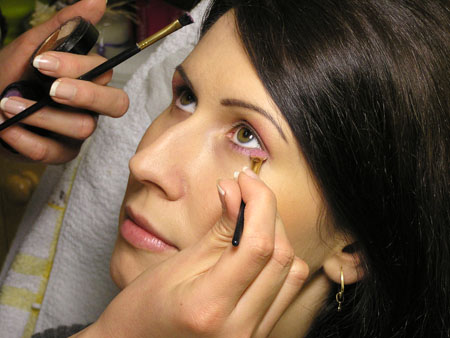Models should exfoliate their skin prior to a photography session and apply a lotion - although not a product with a shimmer. Before applying any make-up, ensure that the model's face is clean by exfoliating with a deep facial wash and then applying a modest amount of moisturizer - too much can create a sheen which lights and camera will render as shiny or sweaty.
 In general, keep the amount of make-up minimal. Too much make up can result in images that make the model appear unnatural - as though a mask is being worn. The application of too much mascara is a common mistake that can lead to an unpleasant clumpy effect that cameras pick up. A good make-up artist will spot a model's best features and try to use them to best advantage. Eyes are always central, so work in that area is often rewarding. If a model has large wide-opening eyes, or eyes of a particularly beautiful or unusual shape, highlight this as much as possible.
In general, keep the amount of make-up minimal. Too much make up can result in images that make the model appear unnatural - as though a mask is being worn. The application of too much mascara is a common mistake that can lead to an unpleasant clumpy effect that cameras pick up. A good make-up artist will spot a model's best features and try to use them to best advantage. Eyes are always central, so work in that area is often rewarding. If a model has large wide-opening eyes, or eyes of a particularly beautiful or unusual shape, highlight this as much as possible.
Powder is a powerful tool in reducing shine and hence skin reflections under powerful lights. Properly applied, it ts use can transform images. The make-up artist should observe the model's face and skin carefully during the shoot and apply a fresh dusting of powder every few minutes. Note that this applies not only to the face but also to the whole body. Arms, legs and even hands can become moist during a shoot. It may also be necessary to touch up eye make-up as the shoot proceeds. Concealer of various types can be used to hide imperfections on the model's body, such as pimples, scratches, bruises and red pressure marks.






